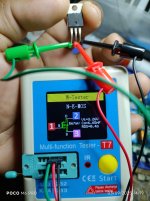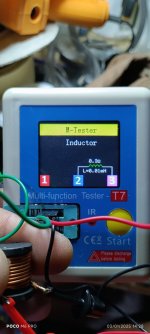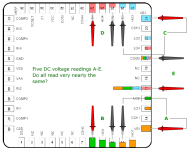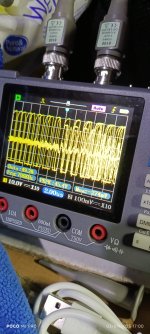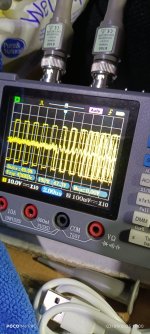FETs in the circuit. The high-side B+ may charge without oscillating but without the FETs oscillating, it won't mean anything. The 4148 diodes are much less than most amps use. Confirm that all are OK.
Also measure the DCV across gate and source terminals of all of the FETs. Do all read approximately the same?
Also measure the DCV across gate and source terminals of all of the FETs. Do all read approximately the same?
Channel 3 and 1 gate and source voltage is less than half a volt. Channels 1 and 2 are 3-3.5 volts.FETs in the circuit. The high-side B+ may charge without oscillating but without the FETs oscillating, it won't mean anything. The 4148 diodes are much less than most amps use. Confirm that all are OK.
Also measure the DCV across gate and source terminals of all of the FETs. Do all read approximately the same?
A 8.7 voltsAfter all channels are oscillating, check the voltage on all of these points.
Check the pads like you did the ICs (previous images) to make sure that there are no abnormal readings.
B 8.7 volts
C 8.7 volts
D 8.7 volts
E 9.6 volts
What's the DCV on all 3 terminals of the 12v regulator feeding the VCC and the VCC2 terminals of the IC?
I've set the PS to 1 amp so when the amplifier starts to draw excess current the voltage drops down to 7 volts and the rail voltage drops to +/- 22 volts. The regular that produces the voltage for VCC and VCC2 is measuring 10 volts on all pins when I just check it.
Should I allow the amplifier to draw more current?
Should I allow the amplifier to draw more current?
Using a 2 ohm resistor to limit current would likely work better.
You can't starve amplifiers for current and expect them to work properly. If all FETs are clamped, it's very difficult to do any damage unless you have much more current available.
You can't starve amplifiers for current and expect them to work properly. If all FETs are clamped, it's very difficult to do any damage unless you have much more current available.
A fuse can be a good option. Try a 5 amp ATC/ATO. If you need to, you can go a bit higher.
I prefer the cylindrical wirewound type like the Ohmite 270 series, 100 watt. 2 ohm is good for most amplifiers. For large amplifiers, you sometimes need to go to 1 ohm (two 2 ohm in parallel). I'd also suggest getting a 12v piezo buzzer to connect across it. It gives an audible indication of a change in current flow.
If you don't want the type shown, any large resistors (100w or larger) will work.
I prefer the cylindrical wirewound type like the Ohmite 270 series, 100 watt. 2 ohm is good for most amplifiers. For large amplifiers, you sometimes need to go to 1 ohm (two 2 ohm in parallel). I'd also suggest getting a 12v piezo buzzer to connect across it. It gives an audible indication of a change in current flow.
If you don't want the type shown, any large resistors (100w or larger) will work.
Attachments
- Home
- General Interest
- Car Audio
- Taramps DS 1200X4 output transistors getting hot and amplifier pulling excess current
